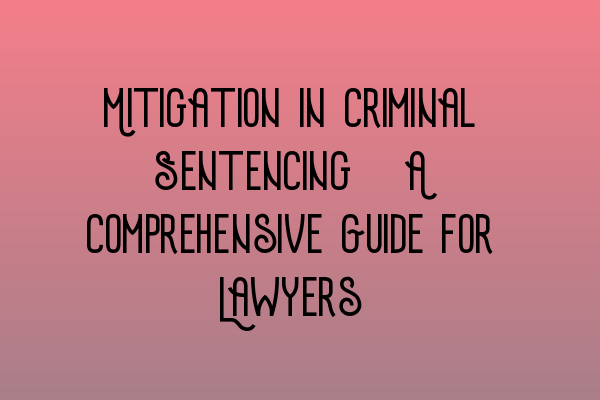Mitigation in Criminal Sentencing: A Comprehensive Guide for Lawyers
When it comes to criminal sentencing, one of the most crucial aspects for lawyers to consider is mitigation. Mitigation refers to the process of presenting evidence and arguments to the court in order to persuade the judge to impose a less severe sentence on their client. In this comprehensive guide, we will explore the importance of mitigation in criminal sentencing and provide practical tips for lawyers to build strong mitigation cases.
Understanding the Role of Mitigation
Mitigation plays a fundamental role in criminal sentencing. It allows lawyers to present evidence and arguments that provide context, shed light on the defendant’s character, and highlight any mitigating factors that may warrant a lesser sentence. Effective mitigation can make a significant difference in the outcome of a case, potentially resulting in reduced prison time, lower fines, or alternative sentencing options.
Key Elements of Successful Mitigation
1. Establishing a Strong Relationship with Your Client: Building trust and understanding with your client is crucial to effectively gather relevant information for mitigation. Conduct thorough interviews, gather character references, and consider obtaining expert testimonies from professionals who can speak to the defendant’s character, mental health, or any other relevant factors.
2. Understanding the Case Circumstances: Familiarize yourself with all aspects of the case, including the nature of the crime, the defendant’s criminal history (if any), and any aggravating factors. This will allow you to identify potential areas of mitigation and craft persuasive arguments to present in court.
3. Presenting Mitigating Factors: Mitigating factors are circumstances that may lessen the defendant’s culpability or provide reasons for leniency. These factors can include remorse, cooperation with authorities, restitution, or evidence of rehabilitation. Clearly articulate these factors and provide supporting evidence to strengthen your mitigation case.
4. Developing Persuasive Arguments: Craft compelling arguments that emphasize the weight of the mitigating factors and why they warrant a reduced sentence. Use case law, sentencing guidelines, and legal precedents to support your arguments and demonstrate why a specific sentence is appropriate.
The Art of Mitigation Presentation
Effective mitigation requires skillful presentation. Here are some tips to enhance your presentation:
- Organize your arguments logically, ensuring a clear flow from start to finish.
- Use persuasive language and techniques to engage the judge and create an emotional connection.
- Support your arguments with concrete evidence, including documents, photographs, or expert testimonies.
- Be concise and avoid unnecessary jargon or technical terms that may confuse the court.
- Prepare your client to speak if appropriate, ensuring their statements align with the mitigation strategy.
Conclusion
Mitigation is a crucial component of criminal sentencing that can significantly impact the outcome of a case. By understanding the role of mitigation, identifying relevant mitigating factors, and presenting persuasive arguments, lawyers can effectively advocate for their clients and help secure the best possible outcome. If you have any questions or need assistance with criminal law matters, contact our expert team at SQE Criminal Law & Practice Law UK. We are here to help.
Related Articles:
- Legal Challenges for UK Businesses in the U.S.: Strategies for Overcoming Hurdles
- SQE Exam Prep: Essential Study Materials for Aspiring Solicitors
- Expert Testimonies in UK Courts: Building Strong Cases
